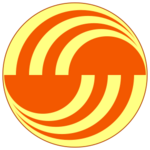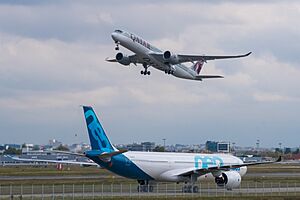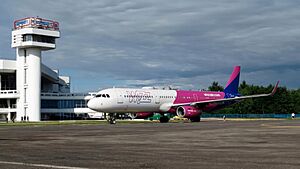Airbus facts for kids
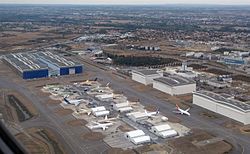
Lagardère production plant in Blagnac, France
|
|
|
Formerly
|
|
|---|---|
| Public (Societas Europaea) | |
| Traded as | |
| ISIN | NL0000235190 |
| Industry | Aerospace, Defence |
| Predecessor | Aérospatiale, CASA, DASA, Matra |
| Founded | 18 December 1970 |
| Headquarters | |
|
Area served
|
Worldwide |
|
Key people
|
|
| Products | |
| Revenue | |
|
Operating income
|
|
| Total assets | |
| Total equity | |
| Owner |
|
|
Number of employees
|
147,893 (2023) |
| Divisions |
|
| Subsidiaries |
|
| Footnotes / references Financials as of 31 December 2022[update]. References: |
|
Airbus SE (/ˈɛərbʌs/; French: [ɛʁbys] ; German: [ˈɛːɐ̯bʊs]; Spanish: [ˈejɾβus]) is a European multinational aerospace corporation. The company’s primary business is the design and manufacturing of commercial aircraft but it also has separate defence and space and helicopter divisions. Since 2019, Airbus has been the world's largest manufacturer of airliners as well as the leading helicopter manufacturer.
The company was incorporated as the European Aeronautic Defence and Space Company (EADS) in the year 2000 through the merger of the French Aérospatiale-Matra, the German DASA and Spanish CASA. The new entity subsequently acquired full ownership of its subsidiary, Airbus Industrie GIE, a joint venture of European aerospace companies originally incorporated in 1970 to develop and produce a wide-body aircraft to compete with American-built airliners. EADS rebranded itself as Airbus SE in 2015. Reflecting its multinational origin, the company operates major offices and assembly plants in France, Germany, Spain, and the United Kingdom, along with more recent additions in Canada, China, and the United States.
Airbus' headquarters are legally registered in Leiden, Netherlands, but daily management is conducted from the company's main office located in Blagnac, France. The SE in its corporate name stands for Societas Europaea. The company is led by CEO Guillaume Faury and is a component of the EURO STOXX 50 stock market index. Since its inception in 2000, the company’s shares have been listed on the Paris Stock Exchange, the Frankfurt Stock Exchange and the four regional Spanish stock exchanges (including the Bolsa de Madrid).
Contents
History
The current company is the product of consolidation in the European aerospace industry, tracing back to the formation of the Airbus Industrie GIE consortium in 1970. In 2000, the European Aeronautic Defence and Space Company (EADS) NV was established. In addition to other subsidiaries pertaining to security and space activities, EADS owned 100% of the pre-existing Eurocopter SA, established in 1992, as well as 80% of Airbus Industrie GIE. In 2001, Airbus Industrie GIE was reorganised as Airbus SAS, a simplified joint-stock company. In 2006, EADS acquired BAE Systems' remaining 20% of Airbus. EADS NV was renamed Airbus Group NV and SE in 2014 and 2015, respectively. Due to the dominance of the Airbus SAS division within Airbus Group SE, the executive committees of the parent and subsidiary companies were aligned in January 2017, but the companies were kept as separate legal entities. The holding company was given its present name in April 2017.
| Airbus (est. 2000, renamed 2017) |
|
||||||||||||||||||||||||
The logos of Airbus Industrie GIE and Airbus SAS displayed a stylized turbine symbol, redolent of a jet engine, and a font similar to Helvetica Black. The logo colours were reflected in the standard Airbus aircraft livery in each period. The EADS logo between 2000 and 2010 combined the logos of the merged companies, DaimlerChrysler Aerospace AG (a four-ray star) and Aérospatiale-Matra (a curved arrow), after which these elements were removed and a new font with 3D shading was chosen. This font was retained in the logos of Airbus Group NV (2014–2015) and Airbus Group SE (2015–2017), then Airbus SE:
-
Original, for Airbus A300
Products
Civilian

The Airbus product line started with the A300 in 1972, the world's first wide-body, twinjet aircraft. The aircraft greatly benefited from the 1976 introduction of the ETOPS 90 rule, which allowed twinjet aircraft to operate up to 90 minutes (increased from 60 minutes) away from the nearest airport. Under the new rule, the A300 was able to operate over the North Atlantic, the Bay of Bengal, and the Indian Ocean more efficiently than the trijets and four-engined jet aircraft offered by competitors. A shorter, re-winged, re-engineered variant of the A300, known as the A310, followed in 1982. The aircraft would remain in production until 2007.

Building on its success with the A300, Airbus worked to develop a narrow-body aircraft along with additional wide-body aircraft based on the A300.
The narrow-body efforts led to the launch of the A320 in 1987, which was and continues to be a major commercial success. The A320 was the first commercial jet to use a digital fly-by-wire control system. All Airbus aircraft developed since then have cockpit systems similar to the A320, making it easier to train crew. The success led Airbus to introduce a lengthened version, the A321 in 1993, along with the shorter A319 in 1995 and the even shorter A318 in 2002. In 2016, Airbus re-engineered the narrow-body family, in a programme called the A320neo (new engine option).
The wide-body programme led to the introduction of the four-engine A340 in 1991 and the twinjet A330 in 1992. At that time, Airbus wanted to offer four-engined jet aircraft to allow for longer transatlantic and transpacific flights. However, during the aircraft's development, new rules extended twinjet operations to 120 minutes in 1986, and 180 minutes in 1989. Although the new rules hurt sales of the A340, they greatly benefited the A330. Production of the A340 ended in 2011, while the A330 would be re-engineered as the A330neo (new engine option) in 2018.
The world's largest passenger airliner was introduced by Airbus in 2005; the A380 was a four-engine aircraft with two full-length passenger seating decks. Intended to challenge the dominance of the Boeing 747 in the long-haul market, the A380 was ultimately a money-losing venture for Airbus due to large development costs and limited sales, and production ended in January 2022.
The A350, a wide-body, twinjet aircraft was introduced in 2013. The A350 was the first Airbus aircraft made largely from carbon-fiber-reinforced polymers. It is longer and wider than the fuselage used on the A300, A310, A330, and A340.
A second narrow-body jet was added to the product list in 2018 when Airbus gained control of the Bombardier CSeries programme, and rebranded it as the A220. The jet offers five-abreast seating compared to the six-abreast seating on the A320.
| Aircraft | Description | Seats | 1st flight | Production end | Orders | Deliveries | Unfilled | In operation |
|---|---|---|---|---|---|---|---|---|
| A220 | 2 engines, narrow-body | 108–130 | 16 September 2013 | 914 | 322 | 592 | 322 | |
| A300 | 2 engines, wide-body | 228–254 | 28 October 1972 | 27 March 2007 | 561 | 561 | — | 219 |
| A310 | 2 engines, wide-body | 187 | 3 April 1982 | 27 March 1998 | 255 | 255 | — | 52 |
| A320 | 2 engines, narrow-body | 107–185 | 22 February 1987 | 18,460 | 11,328 | 7,132 | 10,630 | |
| A330 | 2 engines, wide-body | 246–300 | 2 November 1992 | 1,774 | 1,598 | 176 | 1,479 | |
| A340 | 4 engines, wide-body | 239–377 | 25 October 1991 | 10 November 2011 | 377 | 377 | — | 202 |
| A350 | 2 engines, wide-body | 270–350 | 14 June 2013 | 1,277 | 592 | 652 | 586 | |
| A380 | 4 engines, wide-body, double deck | 555 | 27 April 2005 | 1 January 2022 | 251 | 251 | — | 234 |
Data as of 29 February 2024.
The company is also a 50% owner of the ATR joint venture which builds the ATR 42 and ATR 72 regional aircraft
Corporate jets
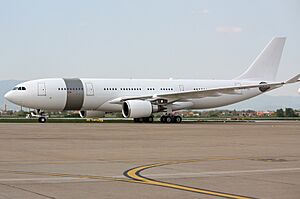
Airbus Corporate Jets markets and modifies new aircraft for private and corporate customers. It has a model range that parallels the commercial aircraft offered by the company. Following the entry of the 737-based Boeing Business Jet, Airbus joined the business jet market with the A319 Corporate Jet in 1997. Although the term Airbus Corporate Jet was initially used only for the A319CJ, it is now often used for all models, including VIP widebodies. As of December 2008, 121 corporate and private jets are operating, and 164 aircraft have been ordered.
The company is also a 10% owner of Dassault Aviation, which builds the Falcon family of smaller business jets.
Military
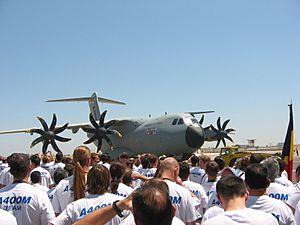
Airbus Defence and Space markets and either builds or modifies new aircraft for military use. Airbus became increasingly interested in developing and selling to the military aviation market in the late 1990s. It embarked on two main fields of development: aerial refuelling with the Airbus A310 MRTT (Multi-Role Tanker Transport) and later the Airbus A330 MRTT, and tactical airlift with the Airbus A400M Atlas. The company has also continued to market and assemble some military aircraft previously offered by the companies that formed Airbus, notably CASA.
The A310 and A330-based MRTT aircraft are conversions of civilian airliners. The aircraft are called multi-role tanker transports because, in addition to their aerial refuelling capability, the aircraft can also be configured for troop transport, medevac, and cargo transportation.
The A400M Atlas is a four-engine, turboprop-powered tactical transport aircraft. The A400M is sized between the American-made C-130 and the C-17 transports, and while it can carry heavier loads than the C-130, its turboprop engines allow it to retain the ability to use rough landing strips. The A400M was developed for European NATO members, Belgium, France, Germany, Luxembourg, Spain, Turkey, and the UK, as an alternative to relying on foreign aircraft. During development, the A400M programme faced delays and cost overruns; with customer nations stepping in offer additional subsidies. The first aircraft was delivered to the French Air Force in 2013, and by 2023, more than 100 aircraft had been built.
The Defence and Space division also market and assembles the Airbus C295, a smaller tactical transport aircraft, that was designed and initially manufactured by the Spanish aerospace company CASA.
The company is also a 50% owner of the ArianeGroup joint venture which builds the Ariane 5 space launch vehicle, a 46% owner of the Eurofighter joint venture which builds the Typhoon fighter jet, a 42.5% owner of the Panavia Aircraft joint venture which built the Tornado fighter jet, a 37.5% owner of the MBDA joint venture which builds missiles, and a 10% owner of Dassault Aviation which builds the Rafale fighter jet, and previously, the Mirage 2000 fighter.
Helicopters
Airbus Helicopters markets and builds new rotorcraft for civilian and military use. The division was founded formed in 1992 as the Eurocopter Group, through the merger of the helicopter divisions of Aérospatiale and DASA (two of the founding companies of Airbus). Airbus Helicopters is the foremost player in the turbine helicopter industry both in terms of revenues and deliveries.
The division's civilian products include the single engine H125 and H130, the light twin engine H135 and H145, the medium twin engine H155 and H160, the super medium twin engine H175, and the heavy twin engine H215 and H225.
Military products include the Tiger attack helicopter, along with militarized versions of the H125, H135, H145, H160, H175, H215, and H225.
The company is also a 62.5% owner of the NHIndustries joint venture, which builds the NH90 military utility helicopter.
Organisation
Divisions
Revenues by division, as of 2023: Commercial aircraft (72%) Defence and Space (17%) Helicopters (11%)
Commercial Aircraft
Commercial aircraft generated 74% of total revenue for the Airbus group in 2018 and 72% in 2023. The key trends for Airbus Commercial Aircraft (excluding Defence, Space and Helicopters) are as of the financial year ending 31 December 2023:
| 2016 | 2017 | 2018 | 2019 | 2020 | 2021 | 2022 | 2023 | |
|---|---|---|---|---|---|---|---|---|
| Revenue (€b) | 49.2 | 43.4 | 47.9 | 54.7 | 34.2 | 36.1 | 41.4 | 47.7 |
| Operating income (€b) | 1.5 | 2.2 | 4.2 | 1.7 | −1.3 | 4.1 | 4.8 | 3.6 |
| Value of order book (€b) | 1,010 | 950 | 411 | 424 | 324 | 345 | 390 | 490 |
| Number of employees | 73,852 | 74,542 | 80,924 | 80,985 | 78,487 | 73,560 | 79,134 | 90,032 |
| Unfulfilled orders | 6,874 | 7,265 | 7,577 | 7,482 | 7,184 | 7,082 | 7,239 | 8,598 |
| Net order intake | 731 | 1,109 | 747 | 768 | 268 | 507 | 820 | 2,094 |
| Aircraft deliveries | 688 | 718 | 800 | 863 | 566 | 611 | 661 | 735 |
Defence and Space
The division Airbus Defence and Space was formed in January 2014 as part of the group restructuring from the former EADS divisions Airbus Military, Astrium, and Cassidian (composed of Cassidian Electronics – develops and manufactures sensors, radars, avionics and electronic warfare systems for military and security applications, Cassidian Air Systems – develops manned and unmanned aerial systems (UAVs), mission avionics, electronic defence and warning systems and Cassidian Systems – provides global security systems such as command & control, lead system integration, TETRA and TETRAPOL communication systems for public safety, industry, transportation and defence. This line of business was the first one in the world to begin field tests with TETRA Enhanced Data Service (TEDS).
- EADS 3 Sigma – a Hellenic company focused on the design, development, production and services provision of airborne and surface target drone systems.
The Airbus Military division, which manufactured tanker, transport and mission aircraft; Airbus Helicopters, the world's largest helicopter supplier; Astrium, provided systems for aerial, land, naval and civilian security applications including Ariane, Galileo and Cassidian. Through Cassidian, EADS was a partner in the Eurofighter consortium as well as in the missile systems provider MBDA.
Helicopters
Airbus Helicopters, formerly known as Eurocopter, is a helicopter manufacturing and support company.
|
Structural evolution of Airbus SE
|
|||||||||||||
| Dec 1970 | Jan 1992 | July 2000 | Sep 2000 | Jan 2001 | Dec 2006 | Apr 2009 | Sep 2010 | Jan 2014 | May 2015 | Jan 2017 | Apr 2017 | ||
| European Aeronautic Defence and Space Company NV | Airbus Group NV | Airbus Group SE | Airbus SE | ||||||||||
| Airbus Industrie GIE | Airbus SAS | ||||||||||||
| Airbus Military SAS | Airbus Defence and Space SAS | ||||||||||||
| EADS Defence and Security | Cassidian SAS | ||||||||||||
| Astrium SAS | EADS Astrium SAS | ||||||||||||
| Eurocopter SA | Eurocopter SAS | Airbus Helicopters SAS | |||||||||||
Subsidiaries
- Airbus APWorks
- AirBusiness Academy
- Airbus Flight Academy
- Airbus Group, Inc. – the U.S. holding company for the North American activities of Airbus Group
- Airbus Transport International – cargo airline managing the transportation of Airbus parts between facilities
- Airbus Protect
- Airbus Crisa
- Dornier Consulting
- GPT
- NAVBLUE
- Premium AEROTEC
- Satair
- Stelia Aerospace
- Testia
- UP42
- VoltAir
Joint ventures
| Name | Holding | Description |
|---|---|---|
| Airbus Canada Limited Partnership |
75%
|
manufacturer of the Airbus A220 family of airliners |
| ArianeGroup |
50%
|
manufacturer of the Ariane 5 and Ariane 6 space launch vehicles |
| ATR |
50%
|
manufacturer of the ATR 42 and ATR 72 regional aircraft |
| Dassault Aviation |
10%
|
manufacturer of the Rafale fighter jet and Falcon business jets |
| Eurofighter |
46%
|
manufacturer of the Typhoon fighter jet |
| MBDA |
37.5%
|
manufacturer of missile systems |
| NHIndustries |
62.5%
|
manufacturer of the NH90 military utility helicopter |
| Panavia Aircraft |
42.5%
|
manufacturer of the Tornado fighter jet |
The 10 largest shareholder of Airbus in early 2024 were:
- Government of France (10.86%)
- Government of Germany (10.84%)
- Government of Spain (4.090%)
- The Children's Investment Fund Management (3.020%)
- Amundi (1.478%)
- Lyxor (0.7017%)
- Crédit Mutuel (0.5964%)
- Crédit Agricole (0.3600%)
- Union Investment (0.2415%)
Senior leadership
The corporate management of Airbus is:
- Chairman: René Obermann (since April 2020)
- Chief Executive: Guillaume Faury (since April 2019)
- Former chairmen
- Franz Josef Strauss (1970–1988)
- Edzard Reuter (1994–1998)
- Jürgen E. Schrempp (1998–2000)
- Manfred Bischoff (2000–2007)
- Arnaud Lagardère (2007–2013)
- Denis Ranque (2013–2019)
- Former chief executives
- Henri Ziegler (1970–1975)
- Bernard Lathière (1975–1984)
- Jean Pierson (1985–1998)
- Noël Forgeard (1998–2005)
- Gustav Humbert (2005–2006)
- Christian Streiff (2006)
- Louis Gallois (2006–2012)
- Tom Enders (2012–2019)
International manufacturing presence
Airbus has several final assembly lines for different models and markets. These are:
- Toulouse, France (A320 family, A330 and A350)
- Airbus Hamburg-Finkenwerder, Hamburg, Germany (A320 family)
- Seville, Spain (A400M and C295)
- Tianjin, China (A320 family)
- Airbus Mobile, Mobile, Alabama, United States (A220 and A320 family)
- Mirabel, Quebec: Airbus Canada originator of the A220
Airbus, however, has a number of other plants in different European locations, reflecting its foundation as a consortium.
For aircraft assembled in Europe, aircraft parts often move between the different factories and the assembly lines via the use of the Beluga and BelugaXL, a fleet modified aircraft capable of carrying entire sections of fuselage. For aircraft assembled in China and the United States, the parts needed to build an aircraft meet in a single European location where they are loaded onto ships for the final journey to the assembly line.
Airbus opened an assembly plant for the A320 family of aircraft in Tianjin, China in 2009. Airbus started constructing a $350 million component manufacturing plant in Harbin, China in July 2009, which will employ 1,000 people. Scheduled to be operated by the end of 2010, the 30,000 square metre plant will manufacture composite parts and assemble composite work-packages for the A350 XWB, A320 families and future Airbus programmes. Harbin Aircraft Industry Group Corporation, Hafei Aviation Industry Company Ltd, AviChina Industry & Technology Company and other Chinese partners hold an 80% stake in the plant while Airbus control the remaining 20%. In 2022, the Tianjin plant finished upgrading works to allow for production of A321. In 2023, during a French state visit to China, Airbus announced that the Tianjin final assembly plant would be expanded with a second production line.
North America is an important region to Airbus in terms of both aircraft sales and suppliers. 2,000 of the total of approximately 5,300 Airbus jetliners sold by Airbus around the world, representing every aircraft in its product line from the 107-seat A318 to the 565-passenger A380, are ordered by North American customers. According to Airbus, US contractors, supporting an estimated 120,000 jobs, earned an estimated $5.5 billion (2003) worth of business. For example, one version of the A380 has 51% American content in terms of work share value.
Plans for a Mobile, Alabama aircraft assembly plant were unveiled by Airbus CEO Fabrice Brégier from the Mobile Convention Centre on 2 July 2012. The plans include a $600 million factory at the Mobile Aeroplex at Brookley for the assembly of the A220, A319, A320 and A321 aircraft. It could employ up to 1,000 full-time workers when operational. Construction began on 8 April 2013, and became operable by 2015, producing up to 50 aircraft per year by 2017.
Financial information
In October 2005 the British Ministry of Defence warned European politicians to stop, as it sees it, interfering in the corporate governance of EADS. The former UK Defence Procurement Minister Lord Drayson hinted that the UK government, a major customer for EADS, may withhold future contracts. "As a key customer, we see it as important for EADS to move in a direction that is free from political interference."
On 4 April 2006, DaimlerChrysler announced its intention to reduce its shareholding from 30 % to 22.5 %. The company places a value of the stake at "approximately €2.0 billion." Lagardère will reduce its holding by an identical amount. However, Caisse des Dépôts et Consignations, a unit of the French government, acquired 2.25 % of EADS. At issue, as a result, is the fact that the German and French shareholdings are now in imbalance.
On 30 August 2006, shortly after the stock price decline caused by the A380 delivery delays, more than 5 % of EADS stock has been reportedly purchased by the Russian state-owned Vneshtorgbank. Now its share is nearly 6 %. In December 2007, Vneshtorgbank sold EADS shares to another state-controlled bank Vneshekonombank. EADS sharers are to be delivered by Vneshekonombank to the charter capital of JSC "United Aircraft Corporation" in 2008.
On 3 October 2006, shortly after EADS admitted further delays in the Airbus 380 programme would cost the company 4.8 billion euros in lost earnings in 2010, EADS shares, traded on the Paris arm of Euronext, were suspended after they surpassed the 10 % loss limit. Trading resumed later in the day with the one-day loss holding at 7 %.
In 2007, Dubai Holding acquired 3.12 % of EADS stock, making the Dubai buy-out fund one of the largest institutional shareholders.
In 2008, EADS had arms sales equivalent to $17.9 billion, which constituted 28 % of total revenue.
In April 2013, Daimler sold its shares in EADS.
As of 22 June 2018[update], 73.6 % of Airbus Group stock is publicly traded on six European stock exchanges, while the remaining 26.4 % is owned by a "Contractual Partnership". As of 26 April 2018, the partnership is owned by SOGEPA (11.1%), GZBV (11.1%) and SEPI (4.2%). SOGEPA is owned by the French State, GZBV is majority owned by KfW, and SEPI is a Spanish state holding company.
In April 2020, Airbus announced that it has cut aircraft production by a third due to the COVID-19 outbreak. According to Guillaume Faury, the company was "bleeding cash at an unprecedented speed." The recession put its survival at stake and presented the need for deep job cuts throughout all Airbus departments. 3,000 workers in France were involved in government-assisted furlough schemes.
| Finances, in € | 2022 | 2021 | 2020 | 2019 | 2018 | 2017 | |
|---|---|---|---|---|---|---|---|
| Sales, in millions | 58,763 |
52,149 |
49,912 |
70,478 |
63,707 |
59,022 | |
| Portion defence sales, in millions | 11,491 |
9,175 |
10,517 |
10,085 |
9,903 |
9,815 | |
| Earnings (losses) before interest and taxes, in millions | 5,325 |
5,342 |
(510) |
1,339 |
5,048 |
2,665 | |
| Research and development expenses, in millions | 3,079 |
2,746 |
2,858 |
3,358 |
3,217 |
2,807 | |
| Consolidated net income (loss), in millions | 4,247 |
4,213 |
(1,133) |
(1,362) |
3,054 |
2,361 | |
| Earnings (losses) per share | 5.40 |
5.36 |
(1.45) |
(1.75) |
3.94 |
3.05 | |
| Dividend per share | 1.80 |
1.50 | None | None | 1.65 |
1.50 | |
| Free cash flow, in millions | 4,324 |
3,511 |
(7,362) |
3,753 |
3,505 |
3,735 | |
| New orders, in millions | 82,521 |
62,007 |
33,290 |
81,195 |
55,521 | – | |
| Order backlog at year end, in millions | 449,241 |
398,439 |
373,127 |
471,488 |
459,525 | – | |
| Portion defence orders, in millions | 47,242 |
43,110 |
38,587 |
38,129 |
39,312 | – | |
| Employees at year end | 134,267 |
126,495 |
131,349 |
134,931 |
133,671 |
129,442 | |
| Accounted for under IFRS; fiscal year ending 31 December. | |||||||
| Finances, in € | 2013 | 2012 | 2011 | 2010 | 2009 | 2008 | 2007 | 2006 | 2005 | 2004 |
|---|---|---|---|---|---|---|---|---|---|---|
| Sales, in millions | 59,256 | 56,480 | 49,128 | 45,752 | 42,822 | 43,265 | 39,123 | 39,434 | 34,206 | 31,761 |
| Earnings (losses) before interest and taxes, in millions | 2,661 | 2,186 | 1,696 | 1,231 | (322) | 2,830 | 52 | 399 | 2,852 | 2,432 |
| Research and development expenses, in millions | 3,160 | 3,142 | 3,152 | 2,939 | 2,825 | 2,669 | 2,608 | 2,458 | 2,075 | 2,126 |
| Consolidated net income (loss), in millions | 1,465 | 1,198 | 1,104 | 584 | (722) | 1,613 | (433) | 199 | 1,769 | 1,342 |
| Earnings (losses) per share | 1.85 | 1.46 | 1.27 | 0.68 | (0.94) | 1.95 | (0.56) | 0.12 | 2.11 | 1.50 |
| Dividend per share | 0.75 | 0.60 | 0.45 | 0.22 | None | 0.20 | 0.12 | 0.12 | 0.65 | 0.50 |
| Free cash flow, in millions | (818) | 3,472 | 958 | 2,707 | 585 | 2,559 | 3,354 | 2,029 | 2,413 | 1,614 |
| New orders, in millions | 218,681 | 102,471 | 131,027 | 83,147 | 45,847 | 98,648 | 136,799 | 69,018 | 92,551 | 44,117 |
| Order backlog at year end, in millions | 686,734 | 566,463 | 540,978 | 448,493 | 389,067 | 400,248 | 339,532 | 262,810 | 253,235 | 184,288 |
| Employees at year end | 144,061 | 140,405 | 133,115 | 121,691 | 119,506 | 118,349 | 116,493 | 116,805 | 113,210 | 110,662 |
| Accounted for under IFRS; fiscal year ending 31 December. | ||||||||||
Environmental record
Airbus has committed to "Flightpath 2050", an aviation industry plan to reduce noise, CO2, and NOx emissions.
Airbus was the first aerospace business to become ISO 14001 certified, in January 2007; this is a broader certification covering the whole organisation, not just the aircraft it produces.
In association with Honeywell and JetBlue, Airbus has developed a biofuel to reduce pollution and dependence on fossil fuels, claiming that this has the potential to replace up to a third of the world's aviation fuel. Algae-based biofuel absorbs carbon dioxide during growth and does not compete with food production. This alternative may be commercially available by 2030 but algae and other vegetation-based fuels are in an early stage of development, and fuel-bearing algae have been expensive to develop. Airbus offers delivery flights to airlines using a 10% biofuel blend in standard engines. The fuel does not cut carbon emissions but is free of sulphur emissions, which demonstrates that the fuel could be used in commercial flights in unmodified engines.
In September 2020, Airbus unveiled three liquid hydrogen-fueled "ZEROe" concept aircraft that it claims could become the first commercial zero-emission aircraft, entering service by 2035.
See also
- Airbus Training Centre Europe
- Aerospace industry in the United Kingdom
- Airbus affair
- Boeing
- Bombardier Aerospace
- Comac
- Competition between Airbus and Boeing
- Competition in the regional jet market
- Embraer
- F-WWAI
- Liebherr Aerospace
- List of preserved Airbus aircraft
- United Aircraft Corporation


